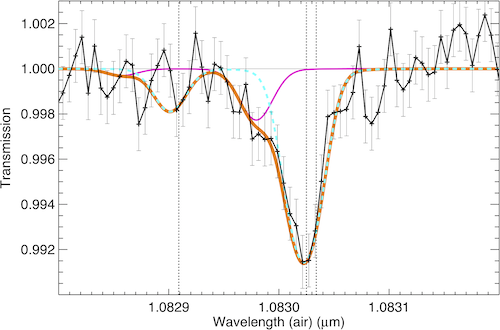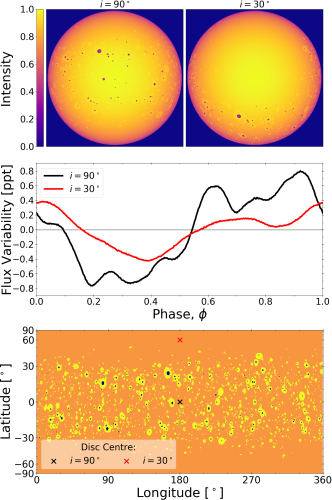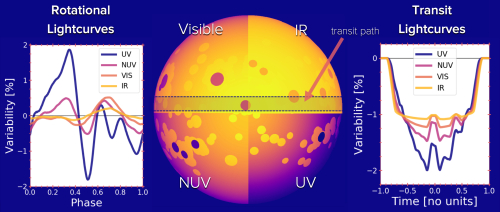Abstract.
The upper atmosphere of HD 209458 b undergoes hydrodynamic escape that is the most atmospheric efficient mass-loss process. Previous works on its characterisation were mainly based on the available Ly-α observations, which provide limited information due to the interstellar medium absorption and the geocoronal emission contamination, and then a high degeneracy in the retrieved atmospheric parameters. Nevertheless, helium triplet lines, hereafter He(23S), are not significantly affected by these processes so that the recent He(23S) absorption spectra measurements by [1] are suitable for retrieving information of the HD 209458 b planetary upper atmosphere. In this work, we significantly improve the characterisation of the upper atmosphere of HD 209458 b by analysing the mid-transit He(23S) spectral absorption measurements. Our study shows that hydrodynamic atmospheric escape expands the thermosphere from the thermobase (that we assume at 1.04 planet's radius, Rp) to the Roche lobe (at 4.22 Rp) by means of a strong and light wind (H/He composition of about 98/2) almost fully ionised beyond 2.9 Rp, in which the He(23S) accumulates at low altitude. Details of this study can be found in [2].
1. Modelling
We applied a 1D hydrodynamic model with spherical symmetry for the structure of the thermosphere coupled with a non-local thermodynamic model for calculating the species density profiles (H, H+, He, He+ and He(23S)). In addition, for retrieving the atmospheric parameters, we calculated the synthetic spectra with a high-resolution radiative transfer model and compared to the He(23S) measured absorption spectrum.
Hydrodynamic continuity equations were solved by assuming a constant speed of sound. This approximation provided us with the same analytical solution than the isothermal Parker wind [3], although we note that constant speed of sound is not necessarily an isothermal approximation. All the production and loss processes (similar to those of [4] but extended), constants and XUV (X-ray and extreme ultraviolet EUV) stellar fluxes used in the study can be found in [2]. The inputs of the model were the maximum temperature, the mass-loss rate (MLR) and the H/He composition of the thermosphere. He(23S) absorption in HD 209458 b was observed with the high-resolution spectrograph CARMENES ([5], [6]) at the 3.5 m Calar Alto Telescope as reported by [1].
The constant speed of sound approximation induces a degeneracy on temperature and MLR, that is added to the degeneracy on the H/He composition. In order to perform a suitable parameter study, we run a grid of simulations for a temperature range from 4000 K to 11500 K and an MLR range from 108 to 1012 g/s for three different H/He compositions, 90/10, 95/5 and 98/2.
2. Results and discussion
Figure 1 shows the spectral transmission of the He(23S) at mid-transit (black line with data points and error bars adapted from [1]) and the synthetic spectrum of one of our simulations that fit this signal (T= 6000 K, MLR of 1.9 x109 g/s and H/He of 90/10, dashed cyan curve). The magenta curve represents an additional absorption necessary to reproduce the signal and the orange curve the total absoprtion. We did not include it in our fit as this gas is probably beyond the Roche lobe.

Fig. 1. Spectral transmission of the He triplet at mid transit (adapted from [2]).
Figure 2 shows the degeneracy in MLR, maximum temperature and H/He composition of the thermosphere, and the strong constraints of the He(23S) spectral absorption measurements on these parameters. We reduced the degeneracy comparing our results with other studies based on the Ly-α measurements of this exoplanet. Comparisons of H density profiles with those of [7], [8] and [9], suggest that H/He is lower than the canonical 90/10, and concluded that the most probable composition among our simulations is 98/2. Comparison of heating efficiencies allowed us to constrain the mass-loss rate, as we adopted the range of 0.1-0.2 according to [10].

Fig. 2 Temperature-MLR curves that fit the He triplet absorption (adapted from [2]).
In summary, the constraints we found in our analysis are i) the MLR is in the range of (0.42-1.00) 1011g/s; ii) the maximum thermospheric temperatures are from 7125 to 8125 K; iii) the H/He composition is about 98/2; iv) the H/H+ transition altitude is in the range of 1.2-1.9 Rp; v) the atmosphere is almost fully ionised beyond 2.9 Rp; vi) the effective radii at which XUV absorption takes place is about 1.16-1.3 Rp, and vii) the average of the mean molecular weight is in the range of 0.61-0.73 g mole-1.
3. Future work
Although our study can constrain the main structure of the hydrodynamic atmospheric escape, more comprehensive 3D magnetohydrodynamic models could reveal more details on the upper atmosphere of HD 209458 b, especially on the kinetic and dynamics of the winds as they could be affected by possible magnetic fields, radiation pressure or interactions with the stellar wind. Currently, we are working in a similar study of the exoplanets HD 189733 b and GJ3470 b.
Acknowledgements.
IAA authors acknowledge financial support from the Spanish MCIU through the “Center of Excellence Severo Ochoa" award (SEV-2017-0709). CARMENES is funded by the German Max-Planck-Gesellschaft (MPG), the Spanish Consejo Superior de Investigaciones Científicas (CSIC), the European Union through FEDER/ERF FICTS-2011-02 funds, the members of the CARMENES Consortium and contributions by the Spanish Ministry of Economy, the German Science Foundation through the Major Research Instrumentation Programme and DFG Research Unit FOR2544 “Blue Planets around Red Stars”, the Klaus Tschira Stiftung, the states of Baden-Württemberg and Niedersachsen, and by the Junta de Andalucía. We acknowledge financial support from Spanish MCIU funds through projects: ESP2016–76076–R, ESP2017-87143-R, BES–2015–074542, BES–2015–073500, PGC2018-098153-B-C31,AYA2016-79425-C3-1/2/3-P.
References
[1] Alonso-Floriano, F.J. et al. 2019, A&A, 629, A110
[2] Lampón, M. et al. 2020, A&A, 636, A13
[3] Parker, E.N. 1958, ApJ, 128, 664
[4] Oklopcic՛, A. & Hirata, C.M. 2018, ApJ, 855, L11
[5] Quirrembach et al. 2016
[6] Quirrembach et al. 2018
[7] Salz, M. et al. 2016, A&A, 586, A75
[8] García-Muñoz, A. 2007, Planetary and Space Science, 55, 1426
[9] Koskinen, T. et al. 2013, Icarus, 226, 1678
[10] Shematovich, V.I. et al. 2014, A&A, 571, A94




